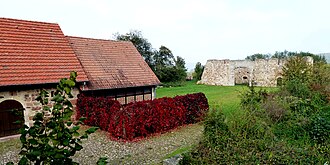Charterhouse Eppenberg

The Eppenberg Charterhouse is a ruined monastery near Gensungen , a district of the town of Felsberg in northern Hesse . The place is still called " Kartause " today, after the monks of the Carthusian order who last lived in the Eppenberg monastery . The Mittelhof state domain is located nearby .
Eppenberg Choir Foundation
Around 1217 the nuns of the Premonstratensian monastery Ahnaberg near Kassel received permission to build a monastery on the Eppenberg, on the slope of the Heiligenberg . On March 3, 1219, Archbishop Siegfried II of Mainz confirmed the founding of the Eppenberg Monastery and took it under his protection. The number of choir women in Ahnaberg was set at 40 and the surplus choir women went to Eppenberg, where they founded the new monastery as a branch of the Ahnaberg monastery.
The relationship with the parent company was obviously not always without problems. In 1223 the provost and the convent of Ahnaberg emphasized their rights in Eppenberg. On February 17, 1224 Archbishop Siegfried once again confirmed the privileges of the Ahnaberg Monastery. But in 1250 the Prioress of Eppenberg openly refused the privileges of the Ahnaberg Abbey, for reasons no longer known today, and Eppenberg became an independent monastery, although like Ahnaberg under the patronage of the Spieskappel Abbey . It soon flourished, mainly through donations and the acquisition of real estate in the nearby villages of Altenbrunslar , Böddiger , Besse and Gensungen. In 1269, the foundation of the Premonstratensian convent St. Georg in Homberg an der Efze was initiated by the provost Arnold von Eppenberg. However, increasing prosperity subsequently led to a decline in morals and discipline, and ultimately to waste, mismanagement and economic decline.
Charterhouse St. Johannis
Landgrave Ludwig I complained bitterly about the conditions in the monastery, the run-down properties and buildings, and the forgotten discipline, discipline and order. At his instigation, the papal bull dissolved the monastery in 1438 and transformed it into a charterhouse for monks from Erfurt who moved in in 1440. The monastery was named “St. Johannis ”and was generously expanded and rebuilt. In 1471, Landgrave Ludwig II gave the monastery the Wimmenhof (today domain Mittelhof) and the nearby, half-ruined Heiligenberg Castle , only made it a condition of the monks that they should pray weekly for his salvation in the castle chapel.
secularization
In 1527, after the Homberg Synod of 1526, with which the Reformation was introduced in Hesse, the monastery was abolished and used by Landgrave Philip I as a hunting lodge and economic property. Around 1610, Landgrave Moritz had the hunting lodge rebuilt based on the model of Italian Renaissance castles. The buildings and lands were co-managed by the nearby Mittelhof. During the Thirty Years' War the complex was destroyed, after which it was converted into a Vorwerk and Schafhof of the Mittelhof state domain. In the Seven Years' War (1756–63), French troops holed up on the hill of the monastery for seven weeks after the lost battle near Grebenstein ; two entrenchments on the slope of the Heiligenberg remind of their camp.
Todays use
In 1957, the main building was struck by lightning and burned down to the walls. The buildings and the monastery church increasingly fell into disrepair until the Felsberg district beekeeping association took over the restoration and maintenance of the complex from 1984 onwards. In the former gatehouse of the monastery, a worth seeing apiculture museum was created . Of the monastery itself, only the ruins of the monastery church remain today.
The area around the Charterhouse and the ruins themselves were placed under nature protection in December 1988.
literature
- Gisela Helmerich: Eppenberg Abbey and Charterhouse. (Sources and treatises on the history of the abbey and diocese of Fulda; 23), Parzeller, Fulda 1979. ISBN 3-7900-0090-6
- Gerhard Schlegel: Eppenberg , in: Monasticon Cartusiense , ed. by Gerhard Schlegel, James Hogg, Volume 2, Salzburg 2004, 406-411.
Web links
- Literature by and about Kartause Eppenberg in the bibliographic database WorldCat
- Carthusian monastery ruins
- Mittelhof domain
Coordinates: 51 ° 8 '38.76 " N , 9 ° 27' 51.12" O

